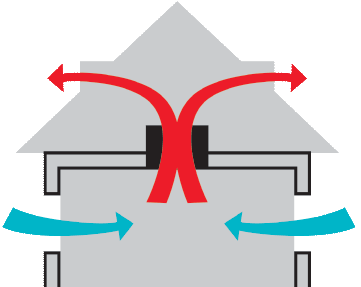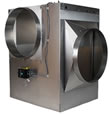
Natural Cooling with Whole House Fans
Whole house fans can reduce or even eliminate air conditioning use by taking advantage of the natural cooling cycles that nature provides.
Here's how they work: The whole house fan is mounted between your living space and the attic, and runs in the evening, night-time and morning, when outside air is cool. The whole house fan draws cool fresh air in through open windows while exhausting hot stale air out through attic roof vents. This circulation creates a fresh and comfortable living environment and, importantly, draws heat out of the structure to reduce and delay heat loading for the next day.
Much improved over old-fashioned designs
Traditional whole house fans are big, noisy and difficult to install. They often require fussy maintenance and are poorly sealed so, in colder climates, can create problems of heat loss and attic condensation in the winter. AirScape whole house fans represent a breakthrough in usability and practicality. They are compact, VERY QUIET, very easy to install and require no maintenance. Plus, they have automatic, insulated doors so they are safe and convenient to use in four-season climates. And total energy use is equivalent to just one or two light bulbs!.
Great for most climates
While especially effective in dry desert climates, whole house fans can be great in other climates as well, though often in shoulder seasons and/or working in conjunction with AC. We've sold our whole house fans all over the country, including New Orleans, Florida and Maine. AirScape and Tamarack fans use less than one tenth the energy of typical AC units, so in almost any climate the fan can help reduce your energy consumption while you enjoy fresh, natural breezes rather than recycled indoor air..
An AirScape or Tamarack whole house fan:
-
saves energy with a smart, elegant cooling that is good for the environment
-
solves the problem of excessive heat accumulation in upstairs bedrooms
-
reduces or eliminates dependence on expensive and wasteful A/C
-
allows you to enjoy fresh air and more natural, livable home
Researching Whole House Fans?
Questions? Call 877-711-4822 or email us: sales@hvacquick.com
Click Picture to See Our Whole House Fans
Whole House Fans
Whole House Fans are used to cool your house during summer evenings. The fans draw cool fresh air in through open windows while exhausting hot stale air out through attic roof vents.
Residential Economizers
Supplies the home’s central air conditioner with outdoor air whenever doing so would be more efficient than conditioning recirculated indoor air, substantially reducing household cooling expenses.

MORE ABOUT AIRSCAPE WHOLE HOUSE FANS

Calculating required air flow
While on the surface it may seem like more cfm equals better cooling, it's not quite that simple. The main function of a whole house fan is not simply to replace hot air with cooler air - it is to cool down the entire structure by drawing off the heat. And this takes time. Even with very high air flow - say 6000 cfm - your house can only shed pent-up heat at a limited rate. So there is a point of diminishing returns that needs to be considered against noise. Eventually you reach a point where you could double the airflow, which would quadruple the noise, yet only speed up the cooling process by 20 or 30%. So what's really effective is slower flow over a longer period with quiet operation.
The Airscape Fans website has an excellent online calculator to help with fan sizing. Check it out here: http://airscapefans.com/system-builder/whf-sizer.php
Operating sound levels
While traditional whole house fans can be very noisy, the computer room fans used in AirScape designs are quiet and efficient. However there is inevitable noise generated by moving high volumes of air. Again, this is where a dual-speed unit can really help. Sound levels at slower fan RPMs are geometrically lower than at high RPMs, so having a low-speed setting for night-time is important if you are sensitive about noise and/or sleeping in close proximity to the fan. Remember: Cooling your house through the night is the key to saving energy and keeping cool with a whole house fan.
Cool climates require leak-free seals for the winter months
This is an important special consideration if you live in a seasonally cold climate. In winter months, when your indoor air is warm and moist compared to outdoors, you do NOT want any air leaking into the cold attic, so the fan unit must provide a positive air seal. Otherwise, not only would you waste energy heating an uninsulated attic, but the moist indoor air would condense on the cold attic surfaces creating potentially serious water, ice and mold problems. AirScape units provide reliable positive seals to protect your home during the heating season.
Energy efficiency
The whole house fan is inherently an energy-efficient device, and AirScape is the leader in energy efficiency. For instance, the AirScape 1.7 uses just 140 watts to push 1700 cfm - compare this nearly 280 watts for a competing 1600 CFM fan, and with the 3300 watts required for a 3 ton AC unit! Durability/Reliability/Warranty A whole house fan is one of those things in life that you just want to work - no maintenance, no breakdowns, no hassles. AirScape units come with a 3-year warranty. As well, the modular design means a faulty component can be swapped on site rather than having to ship the unit out for repairs.
Does it need maintenance?
Most traditional whole house fan designs require periodic maintenance, which can be challenging depending on your attic access. All of the fans we sell are maintenance-free - the fans are sealed and permanently lubricated. Controls/switches AirScape units can be controlled wither with hard-wired switches or optional remote control. Physical requirements The new compact multi-fan units are designed to fit into standard rafter configurations. Near the top of this page is a picture of an AirScape 1.7 as it would sit in the framing of a typical attic.
Make sure you have adequate roof venting
A whole house fan depends on existing roof vents to exhaust air. If there is not enough venting a positive pressure build-up forces hot, dusty attic air back into the house through light fixtures and other cracks. How much venting do you need? Provide one square foot of unobstructed venting for every 450 cfm. Double that if the venting is obstructed by insect screening, louvers, etc. So a 1700 cfm fan would require approximately 4 square feet of unobstructed roof venting. See the table at left. If your house does not have enough, extra roof vents can be added for relatively little expense in most cases.
Tips for using a whole house fan effectively
- Only use it when the outdoor air is cooler than your indoor air.
- Make sure your AC is off when you run the fan or you'll be blowing expensive AC air right out of your house!
- We recommend running your whole house fan all night long. Here's why: The goal is to cool your entire house down, not just the air. It takes time to pull the heat out of the sheetrock, structure and contents of a house. By ventilating all through the night, the house starts the next day thoroughly cooled so you can delay or eliminate running energy consuming air conditioning the next day.
- With two-speed units, use high to quickly cool down the house and low setting to run quietly through the night.
- Never operate the unit without opening a window - this can create negative pressure in the house and cause dangerous backdrafting with gas appliances.
why buy from us?
We're engineers passionate about home ventilation and serious about customer service – so you can count on us for carefully-selected equipment and expert advice to ensure your project is a success from specification to installation.
Your call is answered by qualified people who will gladly discuss your project in detail, advise you professionally and never sell you inappropriate products.


